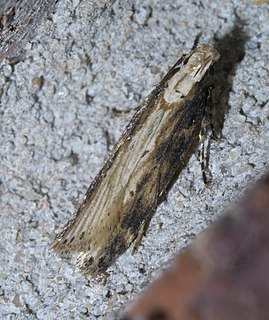| Chionodes occidentella | |
|---|---|
| Scientific classification | |
| Kingdom: | Animalia |
| Phylum: | Arthropoda |
| Class: | Insecta |
| Order: | Lepidoptera |
| Family: | Gelechiidae |
| Genus: | Chionodes |
| Species: | C. occidentella |
| Binomial name | |
| Chionodes occidentella (Chambers, 1875) | |
| Synonyms | |
| |
Chionodes occidentella is a moth in the Gelechiidae family. [1] It is found in North America, where it has been recorded from British Columbia to California and Arizona. [2] [3]

Moths comprise a group of insects related to butterflies, belonging to the order Lepidoptera. Most lepidopterans are moths, and there are thought to be approximately 160,000 species of moth, many of which have yet to be described. Most species of moth are nocturnal, but there are also crepuscular and diurnal species.

The Gelechiidae are a family of moths commonly referred to as twirler moths or gelechiid moths. They are the namesake family of the huge and little-studied superfamily Gelechioidea, and the family's taxonomy has been subject to considerable dispute. These are generally very small moths with narrow, fringed wings. The larvae of most species feed internally on various parts of their host plants, sometimes causing galls. Douglas-fir (Pseudotsuga) is a host plant common to many species of the family, particularly of the genus Chionodes, which as a result is more diverse in North America than usual for Gelechioidea.

North America is a continent entirely within the Northern Hemisphere and almost all within the Western Hemisphere; it is also considered by some to be a northern subcontinent of the Americas. It is bordered to the north by the Arctic Ocean, to the east by the Atlantic Ocean, to the west and south by the Pacific Ocean, and to the southeast by South America and the Caribbean Sea.
The wingspan is 18-19.5 mm. [4] The forewings are clothed with brown and ochreous, in about equal proportions. The costal basal portion is ochreous, passing into greyish-ochreous and brown on the dorsal margin, the extreme base of the costa is dark brown, the costal part of the middle of the wing is dark brown, while, on the dorsal margin, it is pale brown, and in this brown portion on the disc before the middle, are two small oblique velvety-brown streaks. Just before the cilia is a curved ochreous fascia, concave towards the base, distinct on both margins, but indistinct in the middle from the intermixture of brown scales. The apex, behind the fascia, is brown. [5]

The wingspan of a bird or an airplane is the distance from one wingtip to the other wingtip. For example, the Boeing 777-200 has a wingspan of 60.93 metres, and a wandering albatross caught in 1965 had a wingspan of 3.63 metres, the official record for a living bird. The term wingspan, more technically extent, is also used for other winged animals such as pterosaurs, bats, insects, etc., and other fixed-wing aircraft such as ornithopters. In humans, the term wingspan also refers to the arm span, which is distance between the length from one end of an individual's arms to the other when raised parallel to the ground at shoulder height at a 90º angle. Former professional basketball player Manute Bol stands at 7 ft 7 in (2.31 m) and owns one of the largest wingspans at 8 ft 6 in (2.59 m).
The larvae feed on Quercus agrifolia , Quercus douglasii , Ceanothus thyrsiflorus , Ceanothus sorediatus , Cercocarpus betuloides and Arctostaphylos patula .

Quercus agrifolia, the California live oak or coast live oak, is a highly variable, often shrubby evergreen oak tree, a type of live oak, native to the California Floristic Province. It grows west of the Sierra Nevada mountain range from Mendocino County, California, south to northern Baja California in Mexico. It is classified in the red oak section of oaks.

Quercus douglasii, known as blue oak, is a species of oak endemic to California, common in the Coast Ranges and foothills of the Sierra Nevada. It is occasionally known as mountain oak and iron oak.

Ceanothus thyrsiflorus, known as blueblossom or blue blossom ceanothus, is an evergreen shrub in the genus Ceanothus that is endemic to California. The term 'Californian lilac' is also applied to this and other varieties of ceanothus, though it is not closely related to Syringa, the true lilac.


